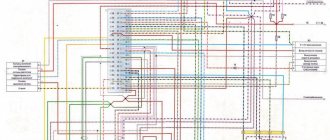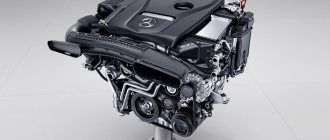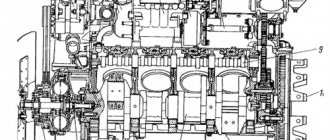The 4g63 engine is one of the most popular four-cylinder in-line engines, which was designed by specialists from the Japanese company Mitsubishi.
This power unit has about a dozen different modifications that were installed on many Mitsubishi models.
The first modification 4G63 appeared back in 1981, and with minor changes continues to be produced to this day. The excellent technical characteristics of this motor are combined with its excellent reliability.
The engines of the 4G63 family are four-cylinder power units that have a volume of 2.0 liters and power from 109 to 144 horsepower. The 4g63 engine has a cast iron cylinder block and an aluminum head, which ensures maximum resistance to overheating.
Depending on its modification, this engine was equipped with DOHC and SOHC gas distribution systems with two or one camshaft.
Initially, this engine was equipped with two valves per cylinder. In the 1990 revision, a modification with 16 valves appeared, which made it possible to obtain the maximum possible power from a two-liter engine.
Specifications
Technical characteristics of the power unit:
Download .xls file
xls
Download picture
Send by email
| PARAMETER | MEANING |
| Years of manufacture | 1981 – present day |
| Engine weight, kg | 160 |
| Cylinder block material | Cast iron |
| Supply system | carburetor/injector |
| Type | in-line |
| Working volume | 1997 |
| Power | 109 horsepower at 5500 rpm |
| Number of cylinders | 4 |
| Number of valves per cylinder | 2 |
| Piston stroke, mm | 88 |
| Cylinder diameter, mm | 85 |
| Compression ratio | 9 |
| Torque, Nm/rpm | 159/4500 |
| Environmental standards | EURO 4 |
| Fuel | 95 |
| Fuel consumption | 13.9 l/100 km combined cycle |
| Oil | 0W-40, 5W-40, 10W-30, 10W-40, 15W-40 and 15W-50 |
| How much oil is in the engine | 4.0 |
| When replacing, pour | 3.5 liters |
| Oil change carried out, km | 10 thousand |
| Engine life, thousand km | |
| - according to the plant | 200 |
| - on practice | 400+ |
4G63 engines are installed on Mitsubishi Eclipse, Galant, L200/Triton, Lancer, Outlander, Space Runner/RVR, Hyundai Elantra, Stellar, Eagle Talon/Plymouth Laser, Dodge Ram 50, Proton Perdana.
Characteristics of 4G63
| Manufacturer | Shenyang Aerospace Mitsubishi Motors Engine Manufacturing Co Ltd Kyoto engine plant |
| Engine make and designation | Sirius |
| Years of manufacture | 1981 to present |
| Cylinder block material (BC) | cast iron |
| Fuel supply system | injector |
| Cylinder arrangement | in-line |
| Number of cylinders | 4 |
| Number per cylinder | 4 |
| Piston stroke length, mm | 88 |
| Cylinder diameter, mm | 85 |
| Compression ratio |
|
| Engine volume, cm3 | 1997 ~ 2.0 liters |
| Motor power, hp/rpm |
(see modifications) |
| Max. torque, Nm/rpm | 159/4500 170/5000 176/4750 (see modifications) |
| Fuel | gasoline, AI-95 |
| Environmental standards | up to Euro 4 |
| Unit weight, kg | 160 |
| Fuel consumption, l/100 km (for Eclipse II) - city - highway - mixed | 13.9 7.3 9.7 |
| Oil consumption, g/1000 km | up to 1000 |
| Characteristics of acceptable motor oil |
|
| Engine oil volume, l | 4.0 |
| When replacing, pour, liters | ~3.5 |
| How often to change engine oil, km | 7 000 — 10 000 |
| Engine operating temperature, degrees. | — |
| ICE resource, thousand km - according to the plant - in practice | — more than 400 |
| Tuning, hp — potential — without loss of resource | 200 hp — |
|
Description
One of the features of this Mitsubishi power unit is the presence of two balancing shafts installed in antiphase. This makes it possible to almost completely eliminate vibrations that occur, especially at maximum engine speeds.
This motor can be used with cars in which the power unit is installed longitudinally and transversely. This made it possible to install 4G 63 with equal ease both on full-size sedans and station wagons, and on compact city cars.
Depending on its modification, this engine was equipped with a carburetor injection system, mono-injection or injector. Regardless of the fuel supply system used, this engine has proven itself to be a highly reliable and durable power unit.
The use of an injector with electric nozzles made it possible to simultaneously increase engine power and improve its fuel efficiency. The power curve was smoothed, which ensured excellent traction even from minimum revs.
Engine tuning 4g63
Technical characteristics of the Toyota Land Cruiser Prado Toyota Land Cruiser Prado 2.7 AT 163 hp 4WD
Car enthusiasts tune the engine installed on Mitsubishi Galant cars and other models. Thus, it is possible to improve the technical characteristics of the power plant. To upgrade the 4G63S4T, perform the following series of actions:
- Replace the camshafts with products with a different phase. Replacing camshafts will make it easier to supply the fuel mixture to the working chamber and remove exhaust gases;
- Eliminate irregularities in the intake tract. This is necessary for the smooth supply of air mass into the combustion chamber;
- Flash the electronic engine control unit.
Firmware of the electronic control unit will allow you to change the timing of fuel injection. This will make it possible to increase the maximum power and dynamic performance of the engine. To reprogram the electronic control unit, specialized equipment is required.
From the above it follows that the Mitsubishi 4g63 engine is a high-quality power unit. The motor is distinguished by high technical performance and unpretentiousness to operating conditions. The engine was installed on various Mitsubishi cars. During production, several modifications were released.
Modifications
- In the mid-eighties, simultaneously with the main engine, the 4g63t modification appeared, which had a turbocharging system and a 12 valve system. This engine was distinguished by increased power, but due to the imperfections of the 4g63t turbine used, it was not widely used. The only exceptions were the sports versions, in which the turbo engine produced about 300 horsepower and provided the cars with enviable dynamic performance.
- In 1986, the 4g63t modification, which also had the name Sirius, was replaced by 4G63. This line of engines used the DOHC gas distribution system, which in turn improved power performance. The 4g63 engine met strict Japanese environmental regulations.
- Soon modifications appeared with four valves per cylinder and an upgraded SOHC gas distribution system. This version of the engine provided excellent dynamics and at the same time had low fuel consumption.
- In 1993, an updated modification of the 4G63 engine appeared, which was equipped with a flywheel secured with seven bolts. The intake system was changed, and a fuel injection system appeared. The 4g64 engine, with minor changes, but under a new designation, has been produced to this day.
Some Chinese manufacturers still use the 4G63 in their cars today, and buyers value this engine for its excellent reliability and maintainability.
Malfunctions
| FAULT | CAUSE |
| The appearance of vibration in 4g63t. | The reason for this may be problems with the balancing shafts, which are poorly lubricated under conditions of increased load, which leads to their vibration and, ultimately, to a wedge. Repair consists of replacing worn balancing shafts. Another weak point of this power unit is the engine mounts, which are recommended to be replaced if vibration occurs. |
| Floating speed. | Problems can be caused by a temperature sensor, injectors, or a dirty throttle valve on carburetor versions of the engine. Repair is complicated by the difficulty of diagnosing a failed element. It is especially difficult to find the cause on older engines that do not allow computer diagnostics of the motor. |
| The appearance of a knocking sound in the engine under load. | By 50 thousand mileage, hydraulic compensators may die, resulting in a characteristic knocking sound and problems with engine operation. Repair in this case will consist of replacing failed hydraulic compensators. As a preventative measure, we can recommend that you use high-quality oil and change it every 10 thousand kilometers. |
Tuning
Engines of the 4G63 series are reliable and have a solid resource for increasing power.
- The simplest tuning option would be to use upgraded shafts, which allow you to get about a 20 horsepower increase in power. Simultaneously with the installation of the shafts, the cold start is replaced, and the firmware in the engine control unit is changed.
- A 4g63t turbocharger can be installed on the naturally aspirated Lancer engine, which allows you to increase engine power by 100-150 horsepower. In this case, the manifold, cylinder head, piston group, pan, liners and fuel pump are changed.
- It is possible to use spare parts from the Evolution sports modification, which allows you to obtain engine power of 200-250 horsepower. It should be said that this type of tuning is highly complex and should be performed exclusively by experienced mechanics.
- A relatively simple and inexpensive way to tune a 4G63 series engine is to use a sports direct-flow exhaust system. Depending on the type of exhaust, the car receives about 20-25 additional horsepower. At the same time, the sound of the engine changes, which acquires sporty notes and begins to sound like a powerful eight-cylinder engine.
Engine design 4g63
Thanks to its design, the Mitsubishi 4g63 engine is a reliable unit that works well regardless of operating conditions. With the help of modernization, you can improve the technical characteristics of the motor several times.
Pistons and crankshaft
The Mitsubishi 4g63 engine has a crankshaft with five main and four connecting rod journals.
For stable engine operation, the crankshaft is equipped with counterweights. There are holes in the necks. They are necessary to supply lubricant to the plain bearings.
The transmission of force from the piston to the crankshaft is carried out using a connecting rod. The engine is equipped with forged connecting rods. A pin is installed on the upper part of the part; it is necessary for the hinge connection of the connecting rod with the piston. A sliding bearing is installed at the bottom of the product. The bearing is secured with a cover.
The engine pistons have grooves for installing compression and oil rings. Compression rings are necessary to prevent leakage of the working mixture from the combustion chamber into the crankcase. Oil scraper rings prevent lubricant from entering the working mixture.
The bottom of the piston is equipped with specialized openings. They are necessary to maintain the integrity of the valve mechanism in the event of a timing belt break. If the timing belt breaks, the open valves will fall into the openings.
Gas distribution mechanism
Depending on the modification, the Mitsubishi engine is equipped with a single-shaft or double-shaft gas distribution mechanism. Cam-type camshafts are driven by a pulley mounted on the crankshaft. A toothed belt is used for drive. The belt tension is automatic. A specialized tensioner is used.
When the camshaft rotates, the cam moves relative to the axis. The moving part of the shaft acts on the valve stem, thereby opening it. In the opposite direction, the valve moves under the action of a spring.
To prevent lubricant from entering the working mixture, the valve mechanism is equipped with oil protective caps.
Cooling system
Between the liners and the walls of the cylinder block there is a cooling jacket. At the top of the block the cooling jacket is open. It communicates with the channels located in the head. This design avoids overheating of the cylinder head regardless of the load.
Forced circulation of liquid in the cooling system is carried out by a pump. It is belt driven by a pulley mounted on the crankshaft. Under the action of the centrifugal force of the pump, the working fluid moves from the cooling jacket to the upper radiator tank. In the radiator, the liquid is cooled by passing through thin channels. From the lower reservoir, the liquid enters the jacket of the power unit.
Cooling of the liquid as it passes through the radiator channels is carried out by air. Forced movement of the air mass through the radiator honeycombs is carried out by an electrically driven fan.
Lubrication system
The Mitsubishi 4g 63 engine has a mixed lubrication system. The rotating parts of the crank mechanism are lubricated with oil sold under pressure. The oil pressure in the system is created by a gear-type pump.
To lubricate the plain bearings, there are holes in the crankshaft journals. When the power plant is operating, oil under pressure is supplied through the holes to the plain bearings. This design allows the bearings to be effectively lubricated regardless of the degree of load on the power unit.
Parts of the gas distribution mechanism and other parts not subject to high loads are lubricated by spraying oil. After splashing, the lubricant flows through the channels into the oil pan.











